With the help of LED strips, you can create beautiful decorative lighting in rooms of a wide variety of purposes. The popularity of the products is due to their numerous advantages, a wide range of applications and a large number of models. To figure out how to install an LED strip in the kitchen, you should understand the principle of operation of the device and the rules for its installation.
- Benefits of LED lighting
- Methods and places of interior lighting in the kitchen
- Classification and comparison of LED strips
- Power supply selection
- Illumination of the table top, dining area
- What is required for installation
- Algorithm for installing lamps
- Tools and materials for mounting LED strips
- Choice of cable cross-section
- Installation of LED strips under kitchen cabinets
Benefits of LED lighting

An increasing number of owners of private and commercial real estate strives to ensure that their property looks original and presentable. One way to fulfill this desire is to install an LED strip in the kitchen.
This decision is supported by the advantages of this light source:
- High color rendering index. Crystals recreate the natural colors found in nature.
- Flexibility. Products can be given complex shapes, used to decorate objects and objects with an angular and curved configuration.
- Easy to install. Fastening is done on an adhesive base.
- Durability. Quality products have a service life of up to 15 years.
- Wide ambient temperature range.
- Possibility of dimming and adjusting various glow modes.
- Safety in terms of electric shock.
- Resistant to moisture and organic fumes.
The set of equipment has an affordable price for all categories of the population.
Methods and places of interior lighting in the kitchen
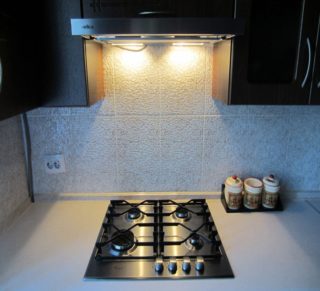
Connecting lighting in the kitchen allows you to give this room a new and unusual look, make it a center for gathering families and holding special events.
To create interior lighting, you can use the following places:
- the box in which the pipes are disguised;
- hood;
- furniture set;
- wall cabinet;
- dinner table;
- apron over the countertop;
- corner shelving;
- plastic profile along the perimeter of the ceiling;
- Kitchen Area;
- window hole;
- floor plinth;
- cornice.
The products can be mounted in any place where they will not interfere and will not suffer from external influences.
Classification and comparison of LED strips
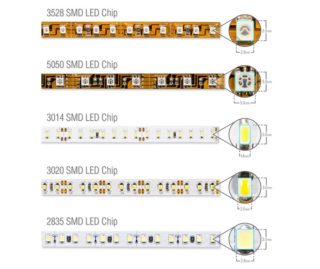
Led strips are available in monochrome and multicolor designs. Products of the first type have LEDs of the same color.
The second row models consist of crystals of three or four colors:
- RGB - red, green, blue;
- RGB + W - red, green, blue, white.
Each row of diodes is connected to a separate channel. There are from 30 to 240 light bulbs on a running meter. Using dimmers of various designs, you can set the parameters of the device in the overflow, pulsation or even lighting mode.
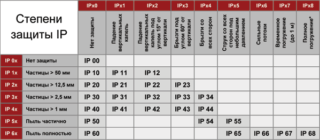
According to the degree of protection against moisture, the products are divided into the following categories:
- Open. Conductive lines are on the surface. When water gets on them, a short circuit occurs. They can be used to decorate objects that are at a sufficient distance from the stove, window and sink.
- One-sided. The conductors are closed from above with a silicone compound.The products are splash-proof and can be installed almost anywhere.
- Double-sided. The strip is packed in plastic. You can attach and connect even inside the sink and hood.
When choosing a tape, you should pay attention not only to tightness, but also to filling. It is advisable to illuminate the tabletop with white. For led lighting for the kitchen under the cabinets, it is better to choose the RGB and RGB + W models.
Power supply selection
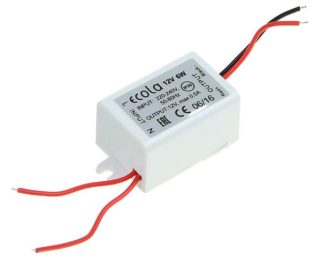
The diode backlight operates on direct current with a voltage of 12 V. To obtain it, an electronic transformer is used, which is powered by a 220 V household network.
Power supplies are classified into the following categories:
- Regular. The electronic filling is located in a steel case, which has holes for cooling. They can be mounted on dry areas of the room.
- Sealed. The products have a closed aluminum or plastic case that protects the contents from moisture. You can fix such products anywhere, without restrictions.
To calculate the power of the converter, you need to multiply the indicator of 1 m of tape by the number of meters (according to the standard there are 5) and add another 30-50% to the result, since the parameters of current consumption change during the operation of the product.
Illumination of the table top, dining area
To illuminate the workspace, it is advisable to use bright monochrome ribbons with white crystals. To achieve maximum brightness, you should use tapes with a density of 120 or 240 diodes per linear meter. To prevent the light from dazzling your eyes, you need to use a U-shaped profile, which will create a narrow strip of light directed to the desktop. It is better to connect the tape and the profile until it is attached to the cabinets.
To decorate the dining area, it is better to use low-power colored products. You can fix the strip at the end of a wooden table or on the bottom along the perimeter on the glass. Run the cable along the leg and connect it to the nearest outlet.
What is required for installation
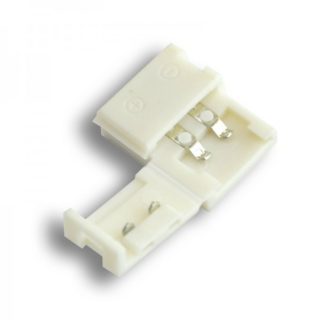
The basis for work is the scheme according to which the tape should be connected to the network.
To carry out the installation, the following equipment must be purchased:
- Dimmer;
- power supply unit (1 x 5 m);
- switch (mechanical, touch, infrared);
- headset for connecting parts of the system;
- controller;
- connector for joining segments.
It is advisable to shop at a store where you can pick up products from one manufacturer. Such electronics work better and last longer.
Algorithm for installing lamps
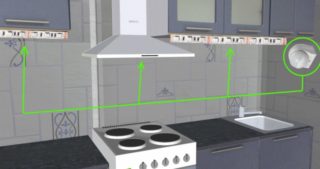
Installation is carried out in the following sequence:
- Drafting a project.
- Markup.
- Degreasing surfaces.
- Screwing the boxes (if provided).
- Bonding tape.
- Docking wires with the controller.
- Connecting the power supply and dimmer.
- Installing the switch.
- Line-to-network connection.
Before starting work, you need to de-energize the room by checking the absence of voltage with the indicator.
Tools and materials for mounting LED strips
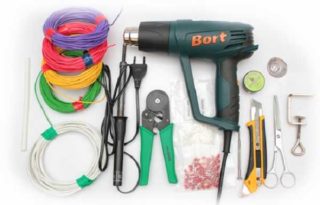
To install an LED lighting system in the kitchen, it is enough to have a standard set of household tools.
For work you will need:
- puncher;
- level;
- roulette;
- tester;
- pliers;
- soldering iron;
- stationery knife;
- insulating tape;
- pencil;
- screwdriver;
- alcohol;
- cotton pads.
If the upper level of the kitchen is to be formed, a stable step-ladder will be required. Wear protective goggles and gloves to avoid injury.
Choice of cable cross-section

The cross-section of the cable cores is selected based on the total load that the assembled structure creates when operating in full mode. Models of monochrome tape SMD-3528 and color SMD-5050 for 1 m consume up to 15 watts. To this is added the power of the dimmer and the power supply, which consume 75-150 watts each. The total is up to 400 watts.Considering that 1 mm² of copper wire can withstand 2 kW, to connect the tape to the network, you need to take a cable with a wire cross-section of 0.3-0.5 mm. In this case, you need to pay attention to the quality of the insulation. Preference should be given to refractory products that do not support combustion.
Installation of LED strips under kitchen cabinets
A feature of the room is a large number of hanging cabinets, which create a feeling of cramped space. You can solve the problem visually by decorating furniture with monochrome and colored ribbons.
You can connect them in an open and semi-closed way. In the first case, colored stripes are glued to the bottom of the shelves in one or more lines, creating soft diffused lighting. The closed version is used to solve two problems: lighting the working area and decor. The tape is fixed in the box away from the apron.

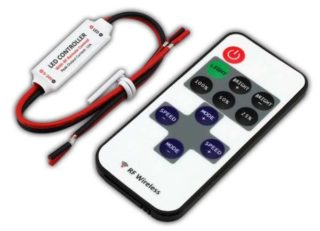

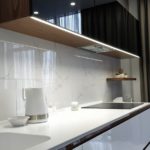
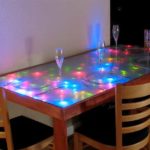
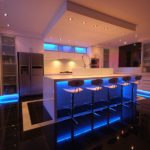








People, if you install an LED strip in the kitchen, then buy a special aluminum profile with a diffuser for this. It has plugs and fasteners. The LED strip is of course glued to the surface, but it also peels off. The profile will not only look aesthetically pleasing (even if the tape inside comes off), but it will also act as a heat sink. The main reason for LED burnout is overheating. Then it's up to you to decide :)